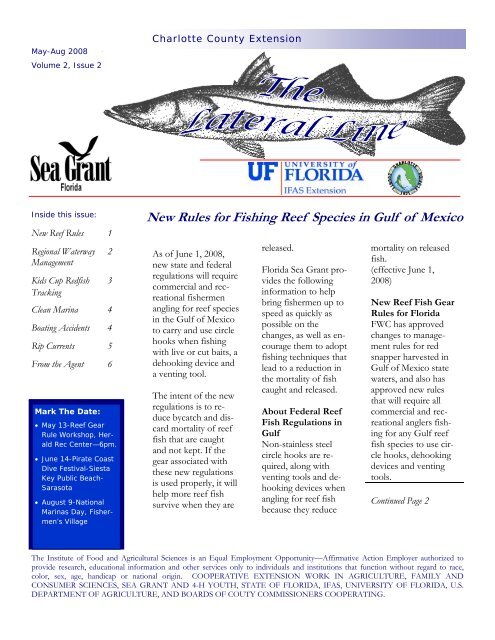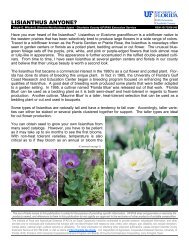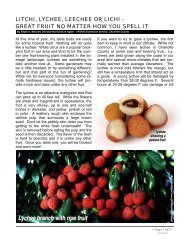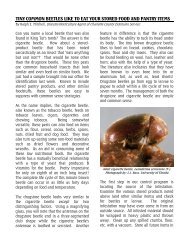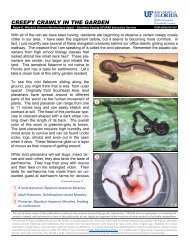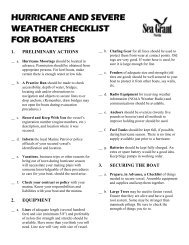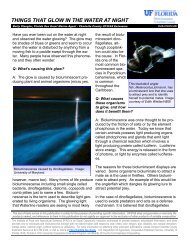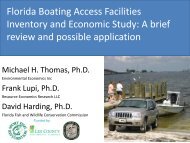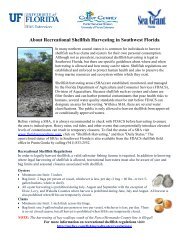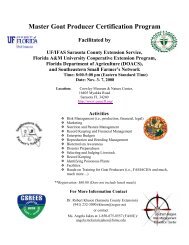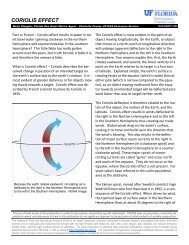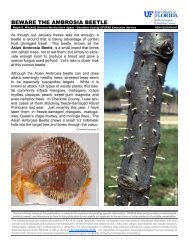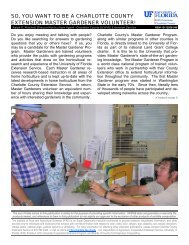New Rules for Fishing Reef Species in Gulf - Charlotte County ...
New Rules for Fishing Reef Species in Gulf - Charlotte County ...
New Rules for Fishing Reef Species in Gulf - Charlotte County ...
Create successful ePaper yourself
Turn your PDF publications into a flip-book with our unique Google optimized e-Paper software.
May-Aug 2008<br />
Volume 2, Issue 2<br />
<strong>Charlotte</strong> <strong>County</strong> Extension<br />
Inside this issue:<br />
<strong>New</strong> <strong>Reef</strong> <strong>Rules</strong> 1<br />
Regional Waterway<br />
Management<br />
Kids Cup Redfish<br />
Track<strong>in</strong>g<br />
2<br />
3<br />
Clean Mar<strong>in</strong>a 4<br />
Boat<strong>in</strong>g Accidents 4<br />
Rip Currents 5<br />
From the Agent 6<br />
Mark The Date:<br />
• May 13-<strong>Reef</strong> Gear<br />
Rule Workshop, Herald<br />
Rec Center—6pm.<br />
• June 14-Pirate Coast<br />
Dive Festival-Siesta<br />
Key Public Beach-<br />
Sarasota<br />
• August 9-National<br />
Mar<strong>in</strong>as Day, Fishermen’s<br />
Village<br />
<strong>New</strong> <strong>Rules</strong> <strong>for</strong> <strong>Fish<strong>in</strong>g</strong> <strong>Reef</strong> <strong>Species</strong> <strong>in</strong> <strong>Gulf</strong> of Mexico<br />
As of June 1, 2008,<br />
new state and federal<br />
regulations will require<br />
commercial and recreational<br />
fishermen<br />
angl<strong>in</strong>g <strong>for</strong> reef species<br />
<strong>in</strong> the <strong>Gulf</strong> of Mexico<br />
to carry and use circle<br />
hooks when fish<strong>in</strong>g<br />
with live or cut baits, a<br />
dehook<strong>in</strong>g device and<br />
a vent<strong>in</strong>g tool.<br />
The <strong>in</strong>tent of the new<br />
regulations is to reduce<br />
bycatch and discard<br />
mortality of reef<br />
fish that are caught<br />
and not kept. If the<br />
gear associated with<br />
these new regulations<br />
is used properly, it will<br />
help more reef fish<br />
survive when they are<br />
released.<br />
Florida Sea Grant provides<br />
the follow<strong>in</strong>g<br />
<strong>in</strong><strong>for</strong>mation to help<br />
br<strong>in</strong>g fishermen up to<br />
speed as quickly as<br />
possible on the<br />
changes, as well as encourage<br />
them to adopt<br />
fish<strong>in</strong>g techniques that<br />
lead to a reduction <strong>in</strong><br />
the mortality of fish<br />
caught and released.<br />
About Federal <strong>Reef</strong><br />
Fish Regulations <strong>in</strong><br />
<strong>Gulf</strong><br />
Non-sta<strong>in</strong>less steel<br />
circle hooks are required,<br />
along with<br />
vent<strong>in</strong>g tools and dehook<strong>in</strong>g<br />
devices when<br />
angl<strong>in</strong>g <strong>for</strong> reef fish<br />
because they reduce<br />
mortality on released<br />
fish.<br />
(effective June 1,<br />
2008)<br />
<strong>New</strong> <strong>Reef</strong> Fish Gear<br />
<strong>Rules</strong> <strong>for</strong> Florida<br />
FWC has approved<br />
changes to management<br />
rules <strong>for</strong> red<br />
snapper harvested <strong>in</strong><br />
<strong>Gulf</strong> of Mexico state<br />
waters, and also has<br />
approved new rules<br />
that will require all<br />
commercial and recreational<br />
anglers fish<strong>in</strong>g<br />
<strong>for</strong> any <strong>Gulf</strong> reef<br />
fish species to use circle<br />
hooks, dehook<strong>in</strong>g<br />
devices and vent<strong>in</strong>g<br />
tools.<br />
Cont<strong>in</strong>ued Page 2<br />
The Institute of Food and Agricultural Sciences is an Equal Employment Opportunity—Affirmative Action Employer authorized to<br />
provide research, educational <strong>in</strong><strong>for</strong>mation and other services only to <strong>in</strong>dividuals and <strong>in</strong>stitutions that function without regard to race,<br />
color, sex, age, handicap or national orig<strong>in</strong>. COOPERATIVE EXTENSION WORK IN AGRICULTURE, FAMILY AND<br />
CONSUMER SCIENCES, SEA GRANT AND 4-H YOUTH, STATE OF FLORIDA, IFAS, UNIVERSITY OF FLORIDA, U.S.<br />
DEPARTMENT OF AGRICULTURE, AND BOARDS OF COUTY COMMISSIONERS COOPERATING.
Page 2 The Lateral L<strong>in</strong>e Volume 2, Issue 2<br />
Regional Waterway Management System<br />
Florida Sea Grant, the<br />
West Coast Inland Navigation<br />
District, and <strong>Charlotte</strong><br />
<strong>County</strong> are partners<br />
<strong>in</strong> a Regional Waterway<br />
Management System<br />
(RWMS) project that will<br />
provide a tool to help balance<br />
coastal resource use<br />
and protection. The<br />
RWMS comb<strong>in</strong>es boat<br />
census <strong>in</strong><strong>for</strong>mation<br />
(especially, boat draft) and<br />
waterway depth data to<br />
provide area-wide <strong>in</strong>sights<br />
<strong>in</strong>to channel ma<strong>in</strong>tenance<br />
needs. The boat census is<br />
under way and will cont<strong>in</strong>ue<br />
through spr<strong>in</strong>g<br />
2008. Crews <strong>in</strong> small<br />
boats are visit<strong>in</strong>g the pr<strong>in</strong>cipal<br />
waterways of the<br />
county, <strong>in</strong>clud<strong>in</strong>g canal<br />
systems, mar<strong>in</strong>as, creeks,<br />
and rivers. They record<br />
<strong>in</strong><strong>for</strong>mation to verify vessel<br />
draft, such as make/<br />
model, length, vessel type,<br />
and estimated age, as well<br />
as the registration number<br />
(“bow number”). The<br />
data is logged <strong>in</strong> a GPS,<br />
along with each vessel’s<br />
position. To help characterize<br />
the capacity of boat<br />
source areas, empty<br />
“moor<strong>in</strong>gs” (wet slips, dry<br />
stack slots, actual moor<strong>in</strong>gs,<br />
anchorages, and so<br />
<strong>for</strong>th) are mapped, too.<br />
The crews try to stay clear<br />
of boats and docks, and<br />
often they use a laser<br />
rangef<strong>in</strong>der to map<br />
Cont<strong>in</strong>ued on pg 5<br />
<strong>Reef</strong> <strong>Rules</strong> (cont<strong>in</strong>ued from page 1)<br />
General Catch-and-<br />
Release In<strong>for</strong>mation<br />
l<strong>in</strong>e to improve the survival<br />
of the fish that they<br />
catch and release.<br />
shapes and sizes; use the<br />
tool that works best <strong>for</strong><br />
the fish you are releas<strong>in</strong>g.<br />
Dehook<strong>in</strong>g tools<br />
Catch-and-<br />
Release:Th<strong>in</strong>gs you can<br />
do to help saltwater fish<br />
survive<br />
<strong>New</strong> brochure with tips<br />
to help saltwater fishermen<br />
<strong>in</strong>crease survival of<br />
fish they catch and release.<br />
Includes <strong>in</strong><strong>for</strong>mation<br />
on 2008 <strong>Gulf</strong> reef<br />
fish regulation changes.<br />
Vent<strong>in</strong>g Fish<br />
Learn<strong>in</strong>g the simple technique<br />
of vent<strong>in</strong>g fish can<br />
help reduce the mortality<br />
of reef fish whose swimbladders<br />
have overexpanded<br />
or burst when<br />
the fish is brought quickly<br />
to surface.<br />
Circle Hooks<br />
Circle Hooks<br />
Circle hooks have been<br />
used by commercial fishermen<br />
<strong>for</strong> decades due to<br />
their ability to efficiently<br />
catch fish, but they can be<br />
used on any species of<br />
fish caught on hook and<br />
Dehookers<br />
De-hook<strong>in</strong>g tools, or dehookers,<br />
are <strong>in</strong>struments<br />
used to dislodge the hook<br />
from the fish’s mouth<br />
without remov<strong>in</strong>g the fish<br />
from the water. Dehookers<br />
come <strong>in</strong> a variety of
Page 3 The Lateral L<strong>in</strong>e Volume 2, Issue 2<br />
Kids Cup Redfish Track<strong>in</strong>g Project<br />
Have you ever wondered<br />
what happens to your fish<br />
when you release it after it’s<br />
weighed <strong>in</strong> at a tournament<br />
If you catch your<br />
redfish <strong>in</strong> P<strong>in</strong>e Island<br />
Sound, do you th<strong>in</strong>k it will<br />
go back Or, will it hang<br />
around <strong>in</strong> the upper harbor<br />
These are great questions,<br />
and the answer is, we<br />
don’t know, but we want<br />
to. This year Kids Cup participants<br />
are help<strong>in</strong>g researchers<br />
learn more about<br />
Redfish behavior and specifically<br />
where Kids Cup<br />
redfish go after be<strong>in</strong>g released.<br />
Thanks to a collaborative<br />
ef<strong>for</strong>t of the Water-<br />
LIFE Kids Cup tournament<br />
and a number of scientific<br />
entities, weighed <strong>in</strong><br />
redfish were tagged as part<br />
of a research and education<br />
program. The beauty of<br />
this tagg<strong>in</strong>g program is that<br />
not only are researchers<br />
hav<strong>in</strong>g the opportunity to<br />
learn about redfish behavior,<br />
so are participants.<br />
At the April 19th Tournament<br />
Weigh Master, Capt.<br />
Ralph tagged every redfish<br />
weighed <strong>in</strong> with a dart tag.<br />
Each tag has a unique identification<br />
number. This tag<br />
is visible to anglers and the<br />
data received from these<br />
tags is almost entirely angler<br />
dependent. What I<br />
mean by this is that researchers<br />
and participants<br />
only receive <strong>in</strong><strong>for</strong>mation<br />
about the tagged fish if an<br />
angler catches the fish, records<br />
the tag number and<br />
location the fish was<br />
caught, and reports these<br />
f<strong>in</strong>d<strong>in</strong>g via the phone number<br />
listed on the tag.<br />
In addition to the dart tags,<br />
20 randomly selected tournament<br />
redfish received a<br />
sonic tag. The sonic tag was<br />
implanted <strong>in</strong>to the redfish<br />
by scientists from Mote<br />
Mar<strong>in</strong>e Laboratory and<br />
Progress Energy. The sonic<br />
tag is not readily visible to<br />
anglers. Data is be<strong>in</strong>g received<br />
from these tags us<strong>in</strong>g<br />
under water sensors<br />
called VR2s (VEMCO).<br />
Mote and Sea Grant have<br />
deployed VR2s along the<br />
path that we suspect redfish<br />
will travel. Each unit is<br />
able receive <strong>in</strong><strong>for</strong>mation<br />
from the sonic tag with<strong>in</strong> a<br />
radius (array) around the<br />
underwater sensor. So if a<br />
sonically tagged fish travels<br />
with<strong>in</strong> the underwater array,<br />
the tag transmits a<br />
unique signal (frequency) to<br />
the VR2 where it is stored.<br />
Weekly, we are go<strong>in</strong>g out to<br />
download the underwater<br />
sensors to receive the data<br />
so that we can see which of<br />
our tagged fish were <strong>in</strong> the<br />
area of the VR2s.<br />
The sonic tags can also be<br />
picked up by a unit deployed<br />
off of the side of a<br />
vessel. This unit is called a<br />
VR100. FWC and Mote<br />
each provided a VR100 <strong>for</strong><br />
the tournament. FWC is<br />
also loan<strong>in</strong>g us theirs <strong>for</strong><br />
some follow up events.<br />
With the VR100 we will<br />
attempt to go out and f<strong>in</strong>d<br />
our tagged fish and follow<br />
them <strong>for</strong> a period of time.<br />
Cont<strong>in</strong>ued on Page 5
Page 4 The Lateral L<strong>in</strong>e Volume 2, Issue 2<br />
Clean Mar<strong>in</strong>as <strong>in</strong> <strong>Charlotte</strong> <strong>County</strong><br />
With the second largest<br />
coastl<strong>in</strong>e <strong>in</strong> America (after<br />
Alaska), Florida has more<br />
registered boaters and mar<strong>in</strong>e<br />
facilities than any other<br />
state. Over 800,000 boats<br />
are registered <strong>in</strong> Florida,<br />
with an additional 400,000<br />
boats estimated to visit the<br />
state annually. Nearly 2000<br />
mar<strong>in</strong>as and boatyards service<br />
these boaters. The Department<br />
of Environmental<br />
Protection (DEP), Florida<br />
Sea Grant, Mar<strong>in</strong>e Industry<br />
Association of Florida, and<br />
U.S. Coast Guard <strong>for</strong>med<br />
the Clean Boat<strong>in</strong>g Partnership<br />
to help susta<strong>in</strong> and<br />
protect Florida’s coastal resources.<br />
As part of the program, mar<strong>in</strong>as<br />
and boatyards can be<br />
certified as a Florida Clean<br />
Mar<strong>in</strong>a or Boatyard by voluntarily<br />
adopt<strong>in</strong>g extra procedures<br />
to elim<strong>in</strong>ate water<br />
pollution at their facility.<br />
Once certified, patrons<br />
know these facilities go the<br />
extra mile to protect local<br />
water quality. Designated<br />
facilities provide pumpouts<br />
<strong>for</strong> sewage disposal, prevent<br />
spills dur<strong>in</strong>g fuel<strong>in</strong>g, and<br />
provide recycl<strong>in</strong>g or disposal<br />
<strong>for</strong> oil, batteries, lights,<br />
switches, and other hazardous<br />
materials. Additionally,<br />
these facilities educate boaters<br />
on how to protect the<br />
environment while boat<strong>in</strong>g.<br />
Who are our Clean Mar<strong>in</strong>as<br />
Palm Island Mar<strong>in</strong>a, 2006<br />
Fishermen’s Village Mar<strong>in</strong>a,<br />
2007<br />
Laishley Mar<strong>in</strong>a, 2007<br />
Isles Yacht Club, 2008<br />
Mar<strong>in</strong>eMax of Cape Haze,<br />
2006<br />
is a Clean Boatyard &<br />
Clean Mar<strong>in</strong>e Retailer<br />
Boat<strong>in</strong>g Accident Stats from 2007<br />
2007 marked a slight <strong>in</strong>crease <strong>in</strong> terms of the number of boat<strong>in</strong>g accidents reported. 668 accidents <strong>in</strong> 2007 compared<br />
to 671 <strong>in</strong> 2006 and a high of 1,159 <strong>in</strong> 1999. The top causes of accidents: operator <strong>in</strong>attention, no proper<br />
look-out, excessive speed, and carelessness/<strong>in</strong>attention.<br />
Source: FWCC Law En<strong>for</strong>cement 2007 Reportable boat<strong>in</strong>g accidents.<br />
<strong>County</strong><br />
Recreational<br />
Vessels<br />
Total Vessels<br />
Reported Accidents<br />
Fatalities Injuries Property Damage<br />
Statewide Rank<br />
Monroe 25,370 28,235 74 4 35 $1,489,795 1<br />
Miami-Dade 59,651 62,324 67 13 30 $809,975 2<br />
Palm Beach 42,968 44,416 52 5 34 $2,310,480 3<br />
P<strong>in</strong>ellas 54,315 56,386 50 4 22 $559,243 4<br />
Broward 38,863 40,407 23 1 9 $164,500 5<br />
Lee 49,095 50,642 32 5 20 $331,800 6<br />
Volusia 30,884 31,891 25 0 13 $93,100 7<br />
Duval 33,630 34,494 23 1 11 $263,867 8<br />
Brevard 38,863 40,407 23 1 9 $164,500 9<br />
Collier 23,504 24,458 18 5 10 $258,300 10<br />
<strong>Charlotte</strong> 21,918 22,613 8 0 6 $24,500 Not Ranked
The Lateral L<strong>in</strong>e Volume 2, Issue 2<br />
Page 5<br />
RWMS (cont. from pg 2)<br />
from a distance. Sometimes,<br />
however, they need<br />
to get <strong>in</strong> close to read the<br />
registration numbers, especially<br />
when boats are<br />
oriented with bows toward<br />
a sea wall.<br />
Two of our research vessels,<br />
a 17 foot Key West<br />
center console fish<strong>in</strong>g<br />
boat and a 13 foot Boston<br />
Whaler Sport, display<br />
University of Florida and<br />
Florida Sea Grant logo<br />
decals. On occasion, the<br />
crews also volunteer use<br />
of their own boats, which<br />
are not so marked.<br />
Kids Cup Redfish Track<strong>in</strong>g (cont. from pg 3)<br />
All of the <strong>in</strong><strong>for</strong>mation collected<br />
(dart & sonic tag) is<br />
com<strong>in</strong>g back to you via this<br />
website designed by Sea<br />
Grant Extension with support<br />
from <strong>Charlotte</strong> <strong>County</strong><br />
GIS. Every angler that<br />
weighed a redfish <strong>in</strong> is<br />
listed. The website <strong>in</strong>teractive<br />
map displays the area of<br />
<strong>Charlotte</strong> Harbor where a<br />
kid’s fish was caught, the<br />
release location (Harpoon<br />
Harry’s), and recorded fish<br />
movement <strong>in</strong> a time series<br />
loop which is be<strong>in</strong>g updated<br />
as data is received. The data<br />
l<strong>in</strong>k allows users to see a<br />
list<strong>in</strong>g of recorded movements<br />
thus allow<strong>in</strong>g users to<br />
conduct their own research.<br />
To Follow a Kids Cup<br />
Fish:<br />
http://<br />
charlotte.ifas.ufl.edu/<br />
kidscup/<strong>in</strong>dex.html<br />
Need Some Local Knowledge—<br />
Call us and ask <strong>for</strong> a FREE<br />
Boaters Guide!<br />
Rip Currents...Don’t Let Them Catch You<br />
Rip currents, often mistakenly<br />
called undertows, can<br />
pull even the most experienced<br />
swimmers from<br />
shore. Rip currents are<br />
<strong>for</strong>med when water is<br />
<strong>for</strong>ced through a narrow<br />
path caus<strong>in</strong>g it to rush out<br />
to sea. Rip currents are frequently<br />
seen around jetties,<br />
gro<strong>in</strong>s, and other barriers,<br />
and can extend 1,000 feet<br />
offshore, reach<strong>in</strong>g widths of<br />
100 feet and speeds of up to<br />
3 miles per hour.<br />
Some rip currents are present<br />
only a few hours; others<br />
are permanent.<br />
Telltale Signs of Rip Currents:<br />
• A noticeable difference<br />
<strong>in</strong> water color (either<br />
murkier or darker)<br />
• A difference <strong>in</strong> waves<br />
(larger, choppier waves<br />
<strong>in</strong> the rip current;<br />
smaller, calmer waves <strong>in</strong><br />
front of the bar)<br />
• Foam or objects mov<strong>in</strong>g<br />
steadily seaward<br />
• An offshore plume of<br />
turbid water past the<br />
sandbars.<br />
What To Do:<br />
If you f<strong>in</strong>d yourself caught<br />
<strong>in</strong> a rip current, most importantly,<br />
Don’t Panic.<br />
Never swim aga<strong>in</strong>st a rip<br />
current. Instead, swim parallel<br />
to shore until you are<br />
out of the current. Rip currents<br />
are rarely more than<br />
30 feet wide. If you can’t<br />
break free of the rip current,<br />
float calmly until the current<br />
dissipates, usually just beyond<br />
the breakers. Once<br />
free, swim diagonally to<br />
shore.<br />
Rip currents can be killers,<br />
so be safe, be smart, and<br />
know what to do.<br />
“Never swim aga<strong>in</strong>st a<br />
rip current. Instead,<br />
swim parallel to shore<br />
until you are out of the<br />
current.”<br />
Rip Current
<strong>Charlotte</strong> <strong>County</strong> Extension<br />
Betty Staugler, Mar<strong>in</strong>e Agent<br />
Email: Staugler@ufl.edu<br />
Roger DeBruler, Jr., Program Assistant<br />
Email: Roger.Debruler@charlottefl.com<br />
<strong>Charlotte</strong> <strong>County</strong> Sea Grant Extension<br />
25550 Harbor View Rd.<br />
Port <strong>Charlotte</strong>, FL 33980<br />
Phone: 941-764-4340<br />
Fax: 941-764-4343<br />
http://charlotte.ifas.ufl.edu<br />
Science Serv<strong>in</strong>g Florida’s Coast<br />
from the Mar<strong>in</strong>e Agent<br />
Do you need a speaker <strong>for</strong> your group Give Roger and I a call. We are happy to<br />
speak on a variety of Sea Grant topics.<br />
Fair W<strong>in</strong>ds & Calm Seas,<br />
Betty Staugler<br />
Florida Sea Grant Extension—<strong>Charlotte</strong> <strong>County</strong>


